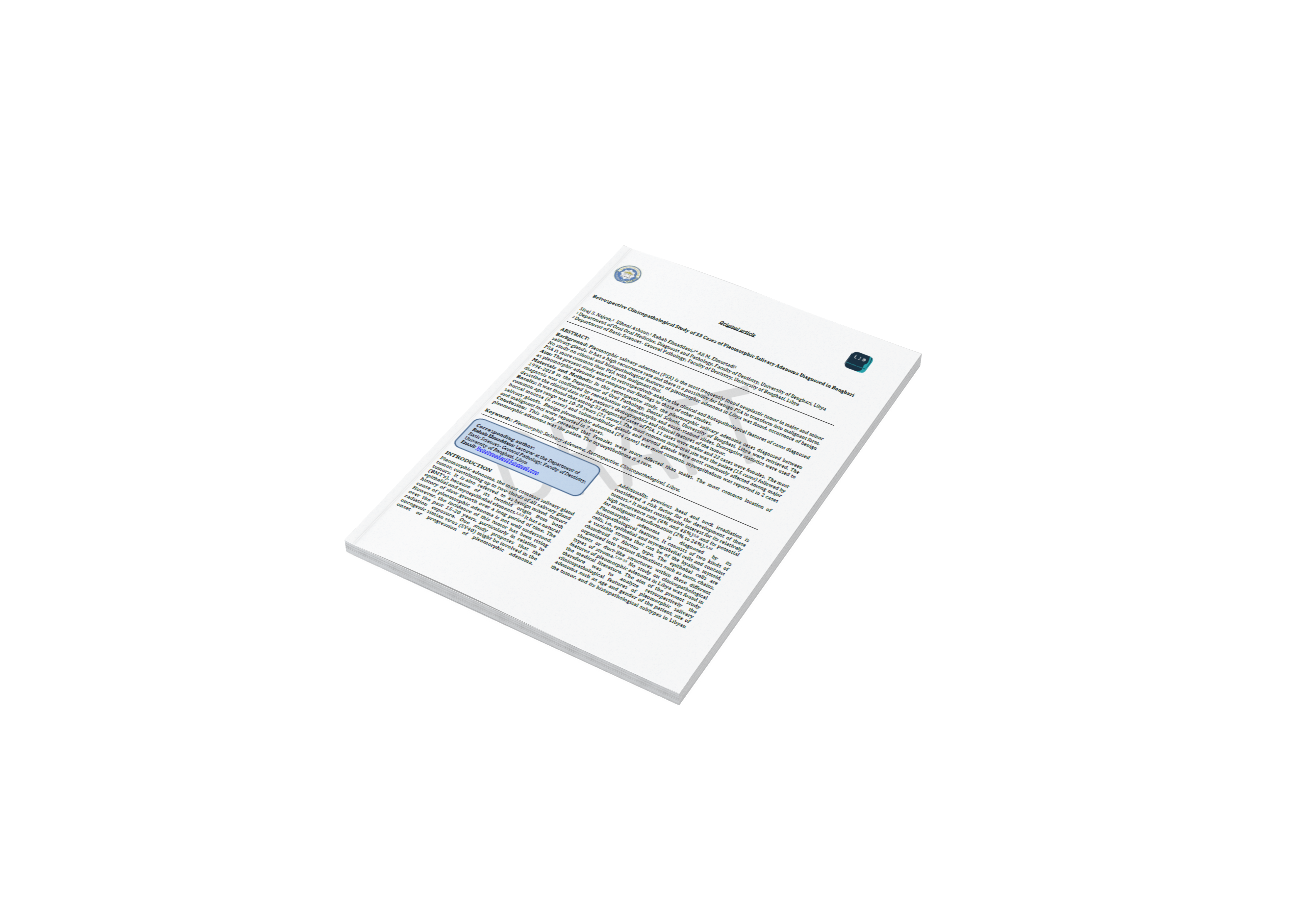Retrospective Clinicopathological Study of 33 Cases of Pleomorphic Salivary Adenoma Diagnosed in Benghazi
DOI:
https://doi.org/10.37376/ljd.v8i2.7155Keywords:
Pleomorphic Salivary Adenoma, Retrospective, Clinicopathological, LibyaAbstract
Background: Pleomorphic salivary adenoma (PSA) is the most frequently found neoplastic tumor in major and minor salivary glands. It has a high recurrence rate and there is a possibility for benign PSA to transform into malignant form. No study on clinical and histopathological features of pleomorphic adenoma in Libya was found. occurrence of benign PSA is more common than PSA with malignant foci.
Aim: The present study aimed to retrospectively analyze the clinical and histopathological features of cases diagnosed as pleomorphic adenoma and compare our findings to those of other studies.
Materials and Methods: In this retrospective study, the pleomorphic salivary adenoma cases diagnosed between 1994-2019 in the Department of Oral Pathology, Dental School, University of Benghazi, Libya were retrieved. The diagnosis was confirmed by reevaluation of hematoxylin and eosin-stained slides. Descriptive statistics were used to describe the clinical data of the patient’s demographics and clinical features of the tumor.
Results: It was found that among 33 diagnosed cases of PSA, 11 cases were males and 22 cases were females. The most common age range was 10-29 years (21 cases). The most common intra-oral site was the palate (15 cases) followed by buccal mucosa (6 cases) and submandibular glands and parotid glands were most commonly affected among major salivary glands. Benign pleomorphic adenoma (24 cases) was most common, myoepithelium was reported in 2 cases and malignant foci were reported in 7 cases.
Conclusion: This study revealed that Females were more affected than males. The most common location of pleomorphic adenoma was the palate. The myoepithelioma is a rare.
Downloads
References
Mc Loughlin L, Gillanders SL, Smith S, Young O. The role of adjuvant radiotherapy in management of recurrent pleomorphic adenoma of the parotid gland: a systematic review. Eur Arch Otorhinolaryngol. 2019 Feb;276(2):283-295.
Lee JH, Kang HJ, Yoo CW, Park WS, Ryu JS, Jung YS, Choi SW, Park JY, Han N. PLAG1, SOX10, and Myb Expression in Benign and Malignant Salivary Gland Neoplasms. J Pathol Transl Med. 2019 Jan;53(1):23-30.
Meshram GG, Kaur N, Hura KS. Pediatric pleomorphic adenoma of the parotid: Case report, review of literature and novel therapeutic targets. Children (Basel). 2018 Sep 18;5(9):e172
Gündüz AK, Yeşiltaş YS, Shields CL. Overview of benign and malignant lacrimal gland tumors. Curr Opin Ophthalmol. 2018 Sep;29(5):458-468.
Renehan A, Gleave EN, McGurk M. An analysis of the treatment of 114 patients with recurrent pleomorphic adenomas of the parotid gland. Am J Surg. 1996;172:710-14.
Donovan DT, Conley JJ. Capsular significance in parotid tumor surgery: reality and myths of lateral lobectomy. Laryngoscope. 1984;94:324-9.
Naeim F, Forsberg MI, Waisman J, et al. Mixed tumors of the salivary glands: growth pattern and recurrence. Arch Pathol Lab Med. 1976;100:271-5.
Krolls SO, Boyers RC. Mixed tumors of salivary glands: long-term follow-up. Cancer. 1972;30:276-81.
Gunn A, Parrott NR. Parotid tumours: a review of parotid tumour surgery in the Northern Regional Health Authority of the United Kingdom 1978–1982. Br J Surg. 1988;75:1144-6
Phillips PP, Olsen KD. Recurrent pleomorphic adenoma of the parotid gland: report of 126 cases and a review of the literature. Ann Otol Rhinol Laryngol. 1995;104:100-4.
Dardick I. Salivary gland tumor pathology: text and color atlas. New York, Tokyo: Igaku-Shoin Medical Publishers; 1996
Ellis GL, Auclair PL. Tumors of salivary glands: atlas of tumor pathology. Washington DC: Armed Forces Institute of Pathology; 1996.
Neville BW, Damm DD, Allen CM, Bouquot JE. Oral and maxillofacial pathology. Philadelphia: W.B. Saunders; 2002.
Sharma S, Mehendiratta M, Chaudhary N, Gupta V, Kohli M, Arora A. Squamous metaplasia in pleomorphic adenoma: a diagnostic and prognostic enigma. J Pathol Transl Med. 2018;52(6):411-5.
Lotufo MA, Junior CA, Mattos JP, Franca CM. Pleomorphic adenoma of the upper lip in a child. J Oral Sci. 2008;50:225-8.
Irani S, Dehghan A, Kalvandi Z. Correlation of clinical and histopathological features of salivary pleomorphic adenoma. J Dent Shiraz Univ Med Sci. 2023;24(4):404-9.
Friedrich RE, Li L, Knop J, Giese M, Schmelzle R. Pleomorphic adenoma of the salivary glands: analysis of 94 patients. Anticancer Res. 2005;25(3A):1703-5.

Downloads
Published
How to Cite
Issue
Section
License
Copyright (c) 2025 Libyan Journal of Dentistry

This work is licensed under a Creative Commons Attribution-NonCommercial-NoDerivatives 4.0 International License.







